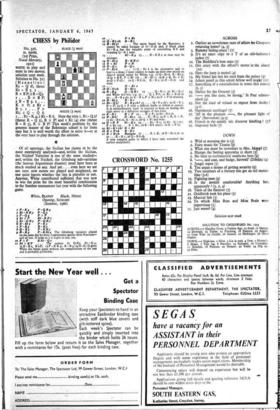CHESS by Philidor
No. 316.
M. HAVEL (1st Prize,
Natal Mercury, 1911) wHrrE to play and mate in two moves; solution next week. Solution to No. 315 (Hannelius):
Kt-- Q 6!, threat B . . R x B P; 25. R Q3.
• . . . B x B P: 2 B - B 3. I. . . K x P; 2 Kt - B 5. x . . P x
BLACK (5 mat) ... Kt - K 4; Kt - K 6. Note the tries 1. Kt - Q 2? (threat R - Q 3), B x P! and x Kt (4) else (threat
B - B 3), R x B P! This week's problem by the greatest master of the Bohemian school is far from easy but it is well worth the effort to solve it-or at the very least to play through the solution.
Of all openings, the Sicilian has claims to be the most extensively analysed-and, within the Sicilian, the Najdorf Variation is one of the most studied- and, within the Najdorf, the Goteborg sub-variation (the famous Argentinian disaster) must have been as much studied as any. And yet . . . even here we are not sure: new moves are played and misplayed, no one quite knows whether the line is playable or not. Anyway, White contributed sufficient that was new to win the prize for the most beautiful combination in the Sombor tournament last year with the following game.
White, BLATNY Black, MINIc Opening, SICILIAN (Sombor, 1966) r P-K P - Q B 4
• Kt-KB3 P-Q3
3 P - Q 4 P x P
4 Kt x P Kt-KB3
5 Kt -Q B3 P-Q R3
6 B-Kt5 P-K3 7 P - B 4 B - K2 8 (2- B3 P - K R 3
g B- R 4 P- K Kt 4 The Goteborg variation played on the same day by three Argentinians against three Russians- and all lost. It looks as if it ought to lose, too.
zo P x P K Kt -Q2
rz Kt x KP . . . The quieter is Q-R5, Kt - K 4; 12B-B2, BxP; 13 P-KR4!, B-B 3;40-0-Ogives White the better game without the complications of the text and is probably preferable.
P Kt
I2 Q - R 5 ch K-Br B-Kt5! . .. The move found by the Russians; it cannot be taken because of 0- 0 ch and, if Black plays Kt - K 4, has the valuable point of controlling K 8 and stopping Q - K z later. Kt -K4 13 . . . R - K R 2 at once may be stronger.
14 B-Kt3 R-KR2!
z5 B x Kt P x B z6R-Qz B-Q2
17 P-Kt6 . . . 17 Q - Kt 6 is the alternative said to
lead to a draw; I leave readers to make up their own minds on this-I would rather be White, e.g. z7 Q - Kt 6, R - Kt 2;
18Q x RP, P x B? (i8 K - Kt z ; B x B, Kt x B; 20Q x Pch); 19Q-Rlich, K -112;290 -0 ch and wins.
R - Kt 2 18 0 - 0 ch K - Kt z
19 B -B4 Q -QBz r9 . . . Q-K I; 20 Kt-Qs! and White will win, e.g. 20 . . Q x??; 21 21 Kt x Bch or
23 B - B 4 ch; 21 K - P x Kt; 2.2 B x P ch winning.
20 B-Kt3 B-Kr 2I Kt-Q5! B-B4ch? 21 Q-B 4 ch!; 22 K -R B x P; 23 Q x P with a difficult battle to follow is correct. It is extraordinarily hard in practice to keep on finding the right move in a defensive struggle of this kind. 22 K - R z R x P 22 B x P; 23 Kt - B 6 ch 23 R-B 6! R - Kt z 23 . . . K - R 2; 24 R x R, B x R; 25 Kt - B 6 ch, K - Kt 2; 26Q x P! and wins. 24 Q xR P -Q2 24 ... Kt-B 3; 25 Kt-K 7 ch!,
B it Kt (25 . . . R x Kt; 26 R- B 8 mate); 26 B it P ch.
25 Kt -K 7 chi B x Kt
26 B x Pek B - B 2
27 B x Bch Resigns 27 . it B; 28 R - Kt 6 ch or 27 ...K-13 i; 28 Q-R 8 ch.
A very complex game in which I have only scratched the surface analytically.






























 Previous page
Previous page